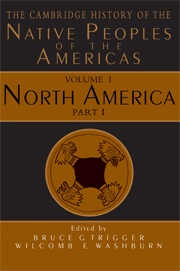Book contents
- Frontmatter
- 1 Native views of history
- 2 Native peoples in Euro-American historiography
- 3 The first Americans and the differentiation of hunter-gatherer cultures
- 4 Indigenous farmers
- 5 Agricultural chiefdoms of the Eastern Woodlands
- 6 Entertaining strangers: North America in the sixteenth century
- 7 Native people and European settlers in eastern North America, 1600–1783
- 8 The expansion of European colonization to the Mississippi Valley, 1780–1880
- Index
- References
4 - Indigenous farmers
Published online by Cambridge University Press: 28 March 2008
- Frontmatter
- 1 Native views of history
- 2 Native peoples in Euro-American historiography
- 3 The first Americans and the differentiation of hunter-gatherer cultures
- 4 Indigenous farmers
- 5 Agricultural chiefdoms of the Eastern Woodlands
- 6 Entertaining strangers: North America in the sixteenth century
- 7 Native people and European settlers in eastern North America, 1600–1783
- 8 The expansion of European colonization to the Mississippi Valley, 1780–1880
- Index
- References
Summary
Throughout much of continental North America that today is included in the eastern and southwestern United States, Native Americans developed mixed economies based on farming New World domesticates combined with important wild foods obtained by hunting and gathering. At the time of contact with Europeans, the Native peoples in these two regions were cultivating many of the same crops. Although there were no real barriers to travel between what is now the western and eastern United States, these areas are markedly different in climate and vegetation. The peoples of these two vast regions followed very different paths in their development of farming economies and in their settlement systems, subsistence strategies, political institutions, and religious beliefs. This chapter explores the similarities and differences between these areas with respect to farming and a settled way of life. Chapter 5 examines the development of ranked agricultural societies characterized by a chiefdom level of socio-political organization in the eastern United States.
In the western region, indigenous farming peoples inhabited the Southwest culture area which forms part of modern Arizona and New Mexico, extending into southeastern Utah and southwestern Colorado. Aridity is the primary climatic feature uniting landscapes of topographic diversity, including rugged mountains, mesas, and broad valleys. The region encompasses the low basins stretching north from the Sonoran and Chihuahuan deserts, the higher and often wooded Colorado Plateaus, and the still higher wooded and forested mountain masses of central Arizona and New Mexico. Prior to and shortly after European contact, Native farming societies extended their settlements onto the undulating short grass plains of Oklahoma and Texas.
- Type
- Chapter
- Information
- The Cambridge History of the Native Peoples of the Americas , pp. 201 - 266Publisher: Cambridge University PressPrint publication year: 1996
References
- 1
- Cited by



